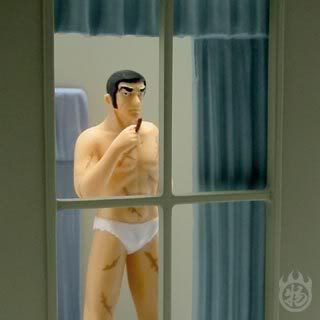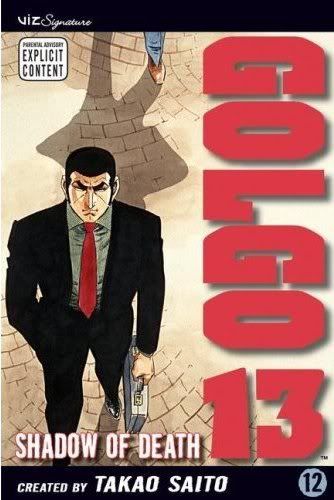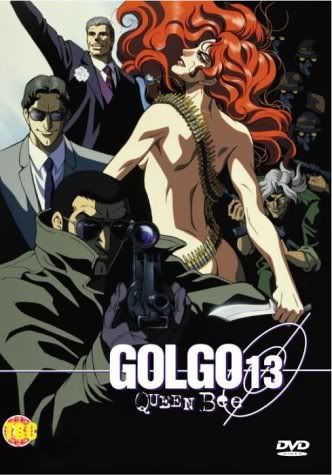To Have and Have Not
Golgo 13 Vol. 12 (of 13): Shadow of Death
You might have gotten word by now that this year will see the debut of a Golgo 13 television anime series, although there's few details out beyond the fact that the project's actually happening. That'll be enough to stoke anticipation though, since even a modest endeavor of the sort will nonetheless constitute the most extensive adaptation of the material to a filmic art - the current total stands at two live-action films (Golgo 13, 1973 & Golgo 13: Kowloon Assignment, 1977), one anime film (Golgo 13, aka: The Professional: Golgo 13, 1983), and one episode of an anime OVA (Golgo 13: Queen Bee, 1998). Unless you count those comics on video.

It can seem odd that there hasn't been more, considering the enduring popularity of the character and the seeming ease with which the concept might fit into a one-off or ongoing project. But a hint might be found in creator Takao Saito's own displeasure with filmic adaptation:
"Whenever there's talk about making a movie, I always oppose it. Because if my concept can be done in a movie, then there's no need to draw it as a gekiga. Gekiga and movies express things in a completely different way. Gekiga are not fit for movies."
That's from his interview in the back of Vol. 11 of this English-language series. It's not a common attitude to run across.
But then, it's not common to see a direct heir to the gekiga tradition still kicking and shouting today, after what will very soon be 40 years of uninterrupted publication. Perhaps the anniversary prompted Saito and company to look around at the very faithful recent adaptations of Osamu Tezuka's works, and opt to finally give it a shot. I don't know for sure, but I strongly suspect these television episodes will be close translations of manga stories, as I believe was the case with the 2004-06 Black Jack television anime. Yet, with roughly 500 manga stories published and no end in sight, there will still be an element of choice at play. If this new anime indeed goes the route of direct adaptation, it will be something to see which stories make the cut.
For example, the current VIZ-published North American run of the manga, which is compiled, edited and adapted to English by Carl Horn, has leaned heavily on tales steeped in factual, political detail specific to the times in which the stories were created; I doubt many of those will make the cut to anime, if only because a continuing television series (as opposed to a winking survey of a long manga series) would otherwise have to confront the fact that its lead character is somehow not in his 60s as of the present day. It would be sort of interesting if Duke Togo aged over the course of the series, actually, but I think everyone involved would find it much easier to set the show in a specific time period, or (better yet!) just do away with historical specifics entirely.
But even that leaves a ton of wiggle room. If I've learned anything from reading thousands of pages of this comic, it's that a lot of different tones can come through, and not all of them will be conductive to anime airing.

This particular installment of the current VIZ run, released just the other week, illustrates the conflict. I very, very much doubt that the upcoming anime will see anything like the book's second story, The Dark-Skinned Sniper (Story #83, April 1974), if only for the sake of market sense. The plot concerns Duke's hiring by a desperate Vietnam veteran for the purposes of wreaking havoc on a powerful Mississippi politico, who ruined the man's POW buddy over signing some anti-war documents at the behest of the Vietcong and -- even worse! -- commiserating with a black man.
The target happens to be holed up in the most racist town in all the United States of America, so Duke opts to fall in with ineffectual local minority radicals while catching rays and popping Methoxsalen (of Black Like Me fame). Meanwhile, the police run around barking racial slurs, tossing black informants down flights of stars, shooting an innocent Japanese auto rep to death and covering up the murder, and generally being racist boobs. An important plot moment centers around Golgo 13 showing everyone his penis, and the mercenary nature of Our Hero is affirmed in that he leaves the racist structures and legal inequities of the area in place as he leaves.
This is just the sort of story I think can only come from a popular culture unconcerned with international reaction. Oh, Saito and his writers are willing to study the situation, sure. They always are. But there's also a distinct air of Visit Exotic America about the story, one that glamorizes its purported danger to non-whites in certain parts of the US - look at that poor Japanese soul, shot to death without a second thought! The Japanese reader is invited to live through Golgo 13, bedding a black woman and 'becoming' black for a while -- and even showing those tragically impotent black radicals how it’s done while remaining stoic, man! -- all while (kinda) standing for justice without having to fuss over the details of living in the area.
It makes sense, for a bit of Japanese escapism steeped in a comics solitude. Could Saito Pro have thought very much about Americans reading this stuff in 1974? That's unlikely. Today, what with the dates carefully positioned at the ends of the stories, and the backmatter happily logging all of the money Golgo 13 must have made over his 40 years of jobs, fully aware of the character's almost absurdly long life, we can read this story as a grabby selection from a long manga history.

But the anime will be beholden to the present, and it will exist in a time of no solitude at all. The Japanese anime industry has become increasingly reliant on foreign licensing fees and the like for sustenance, with attention paid to action-heavy co-productions with US entities, like The Animatrix, Afro Samurai, Highlander: The Search of Vengeance, and the upcoming Batman: The Dark Knight. This isn't to say that ideas critical of the US wouldn't be considered -- you'll hardly find a more anti-US anime plot than that of the semi-recent Queen Bee -- but I suspect as touchy a subject as race in America, particularly when tackled in as indelicate a manner as Golgo 13 dressed in sophisticated blackface to shoot da baddies, would be quickly deleted from consideration. There is history in presentation, but there is immediacy in adaptation.
No, I think broader, more political stories will be considered (again, if direct adaptation turns out to be the way), material like this volume's Shadow of Death (Story #105, March 1976). It's a pretty arty piece for a Golgo 13 exploit, from the early pages of a CIA bigshot's head kept constantly obscured by word balloons or put just off panel to as to emphasize his powerful distance (oooh, just like Chris Ware does!), to the climactic philosophical conversation held between Duke and a KGB doppelgänger he unwittingly follows to a chemical weapons facility in Palau, a place with US/Japanese history. As the two walk, they find bones of Japanese soldiers lining a once-sealed cave, and discuss the nature of their jobs; while the KGB man is fascinated by death, Duke's heart is only set on accomplishment, whatever the result.
It's a familiar approach -- confronting your lead character with a mirror so as to draw out his traits -- and it mixes well with Saito's uniquely positioned, amoral character. It also clings to the political character of the story, casting its critique of US treaty-breaking dirty work as the catalyst for a showdown between the ideologies of killers, the passion and the dispassion. It's this sense of abstraction that lets the content land quietly; it would be prime material for adaptation even without its copious mood or ready-made suspense. Expect more of that on your screen in the months to come.
You might have gotten word by now that this year will see the debut of a Golgo 13 television anime series, although there's few details out beyond the fact that the project's actually happening. That'll be enough to stoke anticipation though, since even a modest endeavor of the sort will nonetheless constitute the most extensive adaptation of the material to a filmic art - the current total stands at two live-action films (Golgo 13, 1973 & Golgo 13: Kowloon Assignment, 1977), one anime film (Golgo 13, aka: The Professional: Golgo 13, 1983), and one episode of an anime OVA (Golgo 13: Queen Bee, 1998). Unless you count those comics on video.

It can seem odd that there hasn't been more, considering the enduring popularity of the character and the seeming ease with which the concept might fit into a one-off or ongoing project. But a hint might be found in creator Takao Saito's own displeasure with filmic adaptation:
"Whenever there's talk about making a movie, I always oppose it. Because if my concept can be done in a movie, then there's no need to draw it as a gekiga. Gekiga and movies express things in a completely different way. Gekiga are not fit for movies."
That's from his interview in the back of Vol. 11 of this English-language series. It's not a common attitude to run across.
But then, it's not common to see a direct heir to the gekiga tradition still kicking and shouting today, after what will very soon be 40 years of uninterrupted publication. Perhaps the anniversary prompted Saito and company to look around at the very faithful recent adaptations of Osamu Tezuka's works, and opt to finally give it a shot. I don't know for sure, but I strongly suspect these television episodes will be close translations of manga stories, as I believe was the case with the 2004-06 Black Jack television anime. Yet, with roughly 500 manga stories published and no end in sight, there will still be an element of choice at play. If this new anime indeed goes the route of direct adaptation, it will be something to see which stories make the cut.
For example, the current VIZ-published North American run of the manga, which is compiled, edited and adapted to English by Carl Horn, has leaned heavily on tales steeped in factual, political detail specific to the times in which the stories were created; I doubt many of those will make the cut to anime, if only because a continuing television series (as opposed to a winking survey of a long manga series) would otherwise have to confront the fact that its lead character is somehow not in his 60s as of the present day. It would be sort of interesting if Duke Togo aged over the course of the series, actually, but I think everyone involved would find it much easier to set the show in a specific time period, or (better yet!) just do away with historical specifics entirely.
But even that leaves a ton of wiggle room. If I've learned anything from reading thousands of pages of this comic, it's that a lot of different tones can come through, and not all of them will be conductive to anime airing.

This particular installment of the current VIZ run, released just the other week, illustrates the conflict. I very, very much doubt that the upcoming anime will see anything like the book's second story, The Dark-Skinned Sniper (Story #83, April 1974), if only for the sake of market sense. The plot concerns Duke's hiring by a desperate Vietnam veteran for the purposes of wreaking havoc on a powerful Mississippi politico, who ruined the man's POW buddy over signing some anti-war documents at the behest of the Vietcong and -- even worse! -- commiserating with a black man.
The target happens to be holed up in the most racist town in all the United States of America, so Duke opts to fall in with ineffectual local minority radicals while catching rays and popping Methoxsalen (of Black Like Me fame). Meanwhile, the police run around barking racial slurs, tossing black informants down flights of stars, shooting an innocent Japanese auto rep to death and covering up the murder, and generally being racist boobs. An important plot moment centers around Golgo 13 showing everyone his penis, and the mercenary nature of Our Hero is affirmed in that he leaves the racist structures and legal inequities of the area in place as he leaves.
This is just the sort of story I think can only come from a popular culture unconcerned with international reaction. Oh, Saito and his writers are willing to study the situation, sure. They always are. But there's also a distinct air of Visit Exotic America about the story, one that glamorizes its purported danger to non-whites in certain parts of the US - look at that poor Japanese soul, shot to death without a second thought! The Japanese reader is invited to live through Golgo 13, bedding a black woman and 'becoming' black for a while -- and even showing those tragically impotent black radicals how it’s done while remaining stoic, man! -- all while (kinda) standing for justice without having to fuss over the details of living in the area.
It makes sense, for a bit of Japanese escapism steeped in a comics solitude. Could Saito Pro have thought very much about Americans reading this stuff in 1974? That's unlikely. Today, what with the dates carefully positioned at the ends of the stories, and the backmatter happily logging all of the money Golgo 13 must have made over his 40 years of jobs, fully aware of the character's almost absurdly long life, we can read this story as a grabby selection from a long manga history.

But the anime will be beholden to the present, and it will exist in a time of no solitude at all. The Japanese anime industry has become increasingly reliant on foreign licensing fees and the like for sustenance, with attention paid to action-heavy co-productions with US entities, like The Animatrix, Afro Samurai, Highlander: The Search of Vengeance, and the upcoming Batman: The Dark Knight. This isn't to say that ideas critical of the US wouldn't be considered -- you'll hardly find a more anti-US anime plot than that of the semi-recent Queen Bee -- but I suspect as touchy a subject as race in America, particularly when tackled in as indelicate a manner as Golgo 13 dressed in sophisticated blackface to shoot da baddies, would be quickly deleted from consideration. There is history in presentation, but there is immediacy in adaptation.
No, I think broader, more political stories will be considered (again, if direct adaptation turns out to be the way), material like this volume's Shadow of Death (Story #105, March 1976). It's a pretty arty piece for a Golgo 13 exploit, from the early pages of a CIA bigshot's head kept constantly obscured by word balloons or put just off panel to as to emphasize his powerful distance (oooh, just like Chris Ware does!), to the climactic philosophical conversation held between Duke and a KGB doppelgänger he unwittingly follows to a chemical weapons facility in Palau, a place with US/Japanese history. As the two walk, they find bones of Japanese soldiers lining a once-sealed cave, and discuss the nature of their jobs; while the KGB man is fascinated by death, Duke's heart is only set on accomplishment, whatever the result.
It's a familiar approach -- confronting your lead character with a mirror so as to draw out his traits -- and it mixes well with Saito's uniquely positioned, amoral character. It also clings to the political character of the story, casting its critique of US treaty-breaking dirty work as the catalyst for a showdown between the ideologies of killers, the passion and the dispassion. It's this sense of abstraction that lets the content land quietly; it would be prime material for adaptation even without its copious mood or ready-made suspense. Expect more of that on your screen in the months to come.
Labels: Golgo 13

<< Home